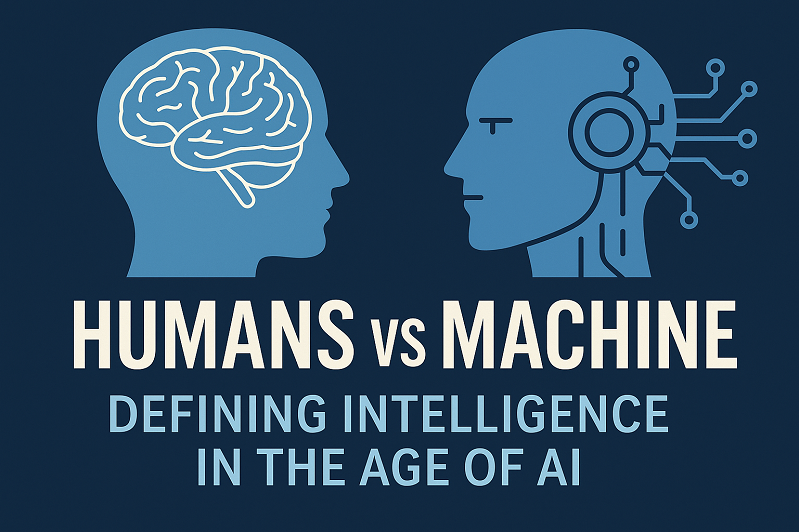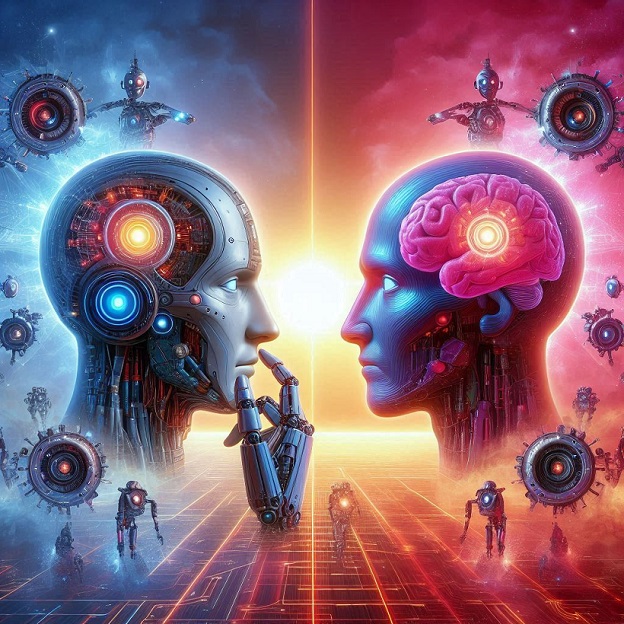Can AI become more intelligent than humans?
AI (Artificial Intelligence) is growing so rapidly that people have begun to wonder—can machines become more intelligent than humans?
The truth is that AI can process data very quickly, make decisions, and understand things that were previously difficult to imagine. However, AI still requires a human brain to function—especially in matters of ethics and making informed decisions. AI cannot understand what social or emotional impact something will have. In such a situation, it is our job to use AI in a way that makes our work easier—not to replace us, but to help us.
AI systems can now process large amounts of data at speeds far exceeding human capability. The ability to analyze and interpret data has significantly progressed in areas like healthcare, finance, and autonomous vehicles! Yet, it’s important to remember that AI still hasn’t captured the emotional depth and understanding that make human intelligence so special.
Can AI Become Like Human Thinking?
Biological processes govern the human brain; our thoughts, emotions, and consciousness are all intricately linked to the brain’s natural structure. We don’t just perceive information; we also feel it. On the other hand, AI is based on machine learning and algorithms. These systems can mimic human thinking to some extent, but they lack experience and emotions. AI can make decisions, but it does so based on data rather than experience. So, the biggest difference between humans and machines is “feeling” and “experience”—something that no machine today can understand.

- AI is great when tasks require speed and accuracy, such as analyzing data or identifying patterns, but when it comes to empathy and moral judgment, AI falls short.
- Human intelligence is characterized by its flexibility—we can apply our knowledge to new situations and contexts. We put things in context, which makes our thinking more in-depth and practical. These qualities are completely absent from today’s AI.
- AI relies on data. It can mirror human thinking, but it cannot repeat our understanding, experience, and intuition.
Human vs Machine Intelligence: Decrease the gap
The convergence between Human vs Machine intelligence brings many challenges and new opportunities. As AI advances, it is important to think—is this technology meant to replace our abilities or enhance them?
If we harness the strengths of both humans and machines correctly, we can create systems that enhance our efficiency, solve difficult problems, and improve the quality of life.
In many fields, human-machine collaboration can lead to creative and innovative solutions. AI, for instance, is highly accurate at analyzing scans and medical images, but human experience and empathy are crucial for patient care.
Similarly, in the creative field, AI can form the basis of new ideas and designs, but only human artists can add emotions and depth to them.
Decreasing the gap between machines and humans requires a sensible and balanced approach that values the strengths of both. By doing so, we can develop technology that helps humans—not replaces them, but enhances them.
AI vs Human Brain: Understanding the Unique Features
The human brain is a fantastic example of biological engineering. It can process information and generate emotions. It is made up of a complex network of billions of neurons (cells like nerves) that give us the ability to learn, remember, and make decisions.
In comparison, Artificial Intelligence (AI) works in a completely different way. AI is also built based on “neural networks,” but it is completely artificial and differs significantly from the biological capabilities of the human brain.
The human brain not only understands information but also recognizes emotions, morality, and social contexts. This is the reason why humans can make decisions wisely and sensitively in complex situations, which is not possible with AI technology.
Human and Machine Learning: Moving Forward Together
Learning is the core of both human and machine intelligence. Human learning is a lifelong process in which we acquire knowledge through experience, observation, and guidance. This learning is deeply connected to social interaction and emotional development.
On the other hand, machine learning is a technical process in which computer algorithms are trained on data to recognize patterns and make predictions.
The combination of human and machine learning can lead to many new and exciting opportunities. When human intuition and creativity merge with the analytical power of AI, we can develop systems that are not only powerful but also significantly more useful.
AI can customize learning for students, while teachers can teach them ethics, thinking, and direction.
Human Brain vs AI: Differences in Thinking Power
The depth of knowledge in the human brain separates it. We are not only people who understand knowledge but also include feelings, empathy, and self-reflection. Our method of thinking is founded not only on reason but also on experience and emotional connection, which makes us self-aware.
AI has limitations on its programming and data, regardless of how fast or accurate it is. It cannot experience feelings or grasp the greater significance of a scenario. Conversely, the human brain is capable of understanding small details, exhibiting empathy, and making the correct choices—qualities that far surpass those of any modern machine.
This difference makes us think about how to use artificial intelligence to help people instead of replacing them. Integrating technology with human knowledge and feeling helps us achieve a balance in which both can achieve something larger and better together.
Definition of Human Intelligence: Not just calculations, but also emotions
Human intelligence is not just the ability to solve problems or make quick decisions. It has much more depth and similarity. We include not just languages, but also spices, traditions, and moral thinking. Our intelligence provides us with the services of adapting to the seashore, collaborative thinking, and connecting with websites.
In today’s era of AI, it is said that geniuses can accomplish a great deal, but they cannot replicate human understanding and emotion. AI can make our work easier, but it cannot replace the depth and breadth of our thinking.
If we create classical systems together by combining human and machine intelligence, we can create systems that are not only faster but also capable of sending messages and thoughts, which will lead us to a better and more advanced future, where technology does not replace humans but rather enhances their capabilities.






